Strategic Analysis of IKEA: Environment, Internal Factors, and Forces
VerifiedAdded on 2023/01/11
|18
|4658
|76
Report
AI Summary
This report offers a comprehensive analysis of IKEA's business strategy. It begins with an introduction to IKEA, outlining its vision, mission, and business objectives. The report then delves into the impact of the macro-environment on IKEA using PESTLE analysis, examining political, economic, social, technological, legal, and environmental factors. Following this, the report assesses IKEA's internal environment through the VRIO model and SWOT analysis, evaluating its resources and capabilities. Furthermore, it applies Porter's Five Forces framework to analyze the competitive landscape of the retail industry. Finally, the report explores strategic management planning, including an examination of IKEA's stakeholders, and concludes with a summary of key findings and strategic recommendations. The report utilizes academic sources to support the analysis and evaluation of IKEA’s strategy.
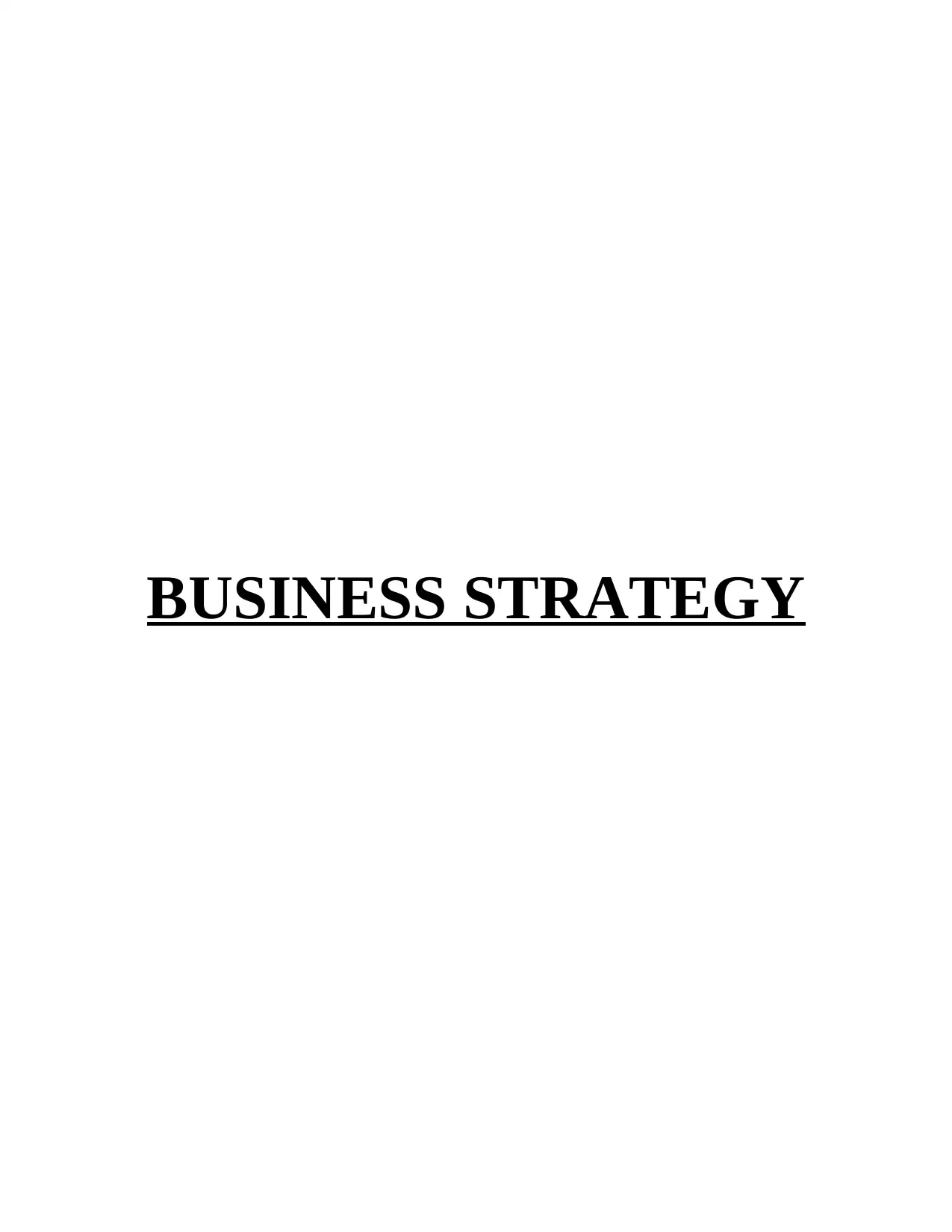
BUSINESS STRATEGY
Paraphrase This Document
Need a fresh take? Get an instant paraphrase of this document with our AI Paraphraser
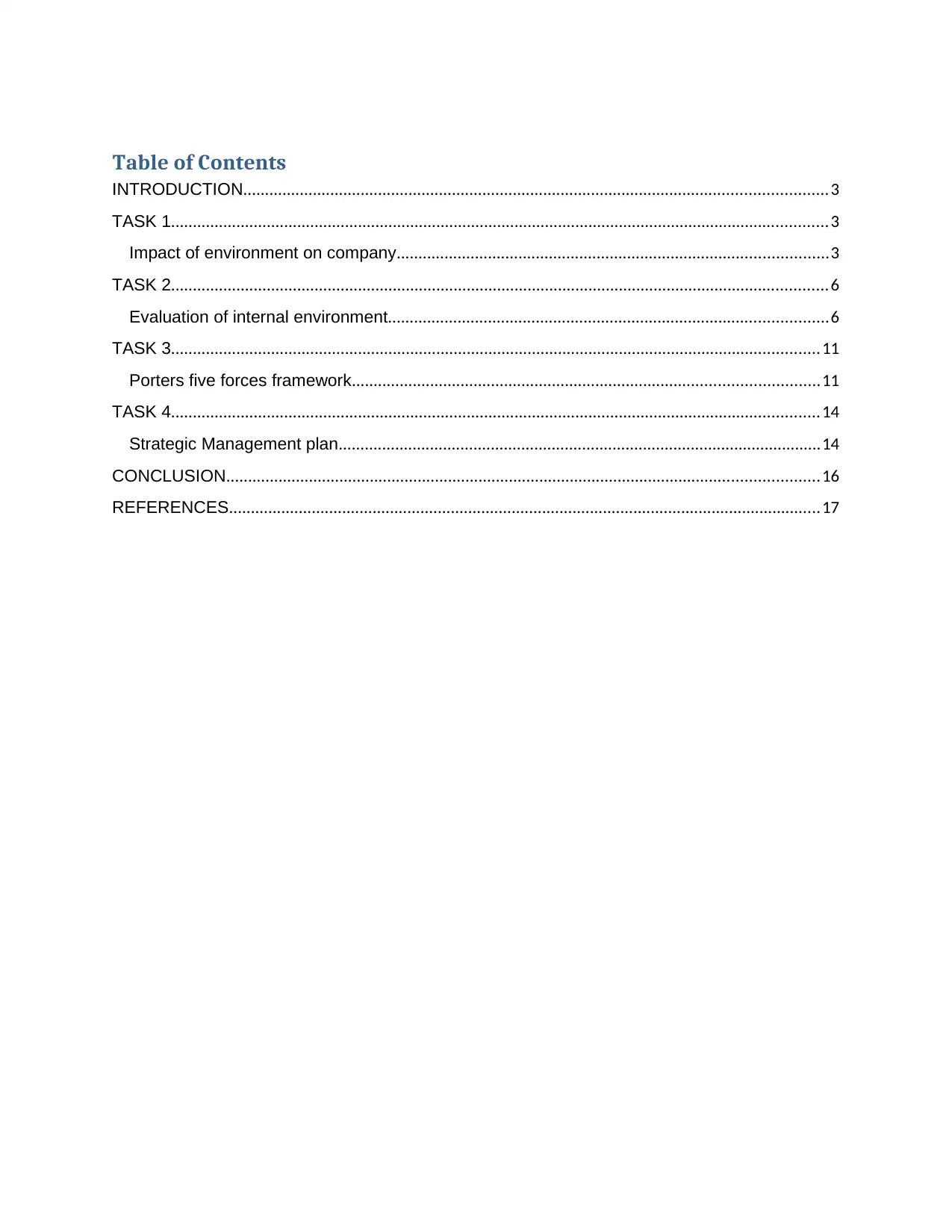
Table of Contents
INTRODUCTION......................................................................................................................................3
TASK 1.......................................................................................................................................................3
Impact of environment on company...................................................................................................3
TASK 2.......................................................................................................................................................6
Evaluation of internal environment.....................................................................................................6
TASK 3.....................................................................................................................................................11
Porters five forces framework...........................................................................................................11
TASK 4.....................................................................................................................................................14
Strategic Management plan...............................................................................................................14
CONCLUSION........................................................................................................................................16
REFERENCES........................................................................................................................................17
INTRODUCTION......................................................................................................................................3
TASK 1.......................................................................................................................................................3
Impact of environment on company...................................................................................................3
TASK 2.......................................................................................................................................................6
Evaluation of internal environment.....................................................................................................6
TASK 3.....................................................................................................................................................11
Porters five forces framework...........................................................................................................11
TASK 4.....................................................................................................................................................14
Strategic Management plan...............................................................................................................14
CONCLUSION........................................................................................................................................16
REFERENCES........................................................................................................................................17
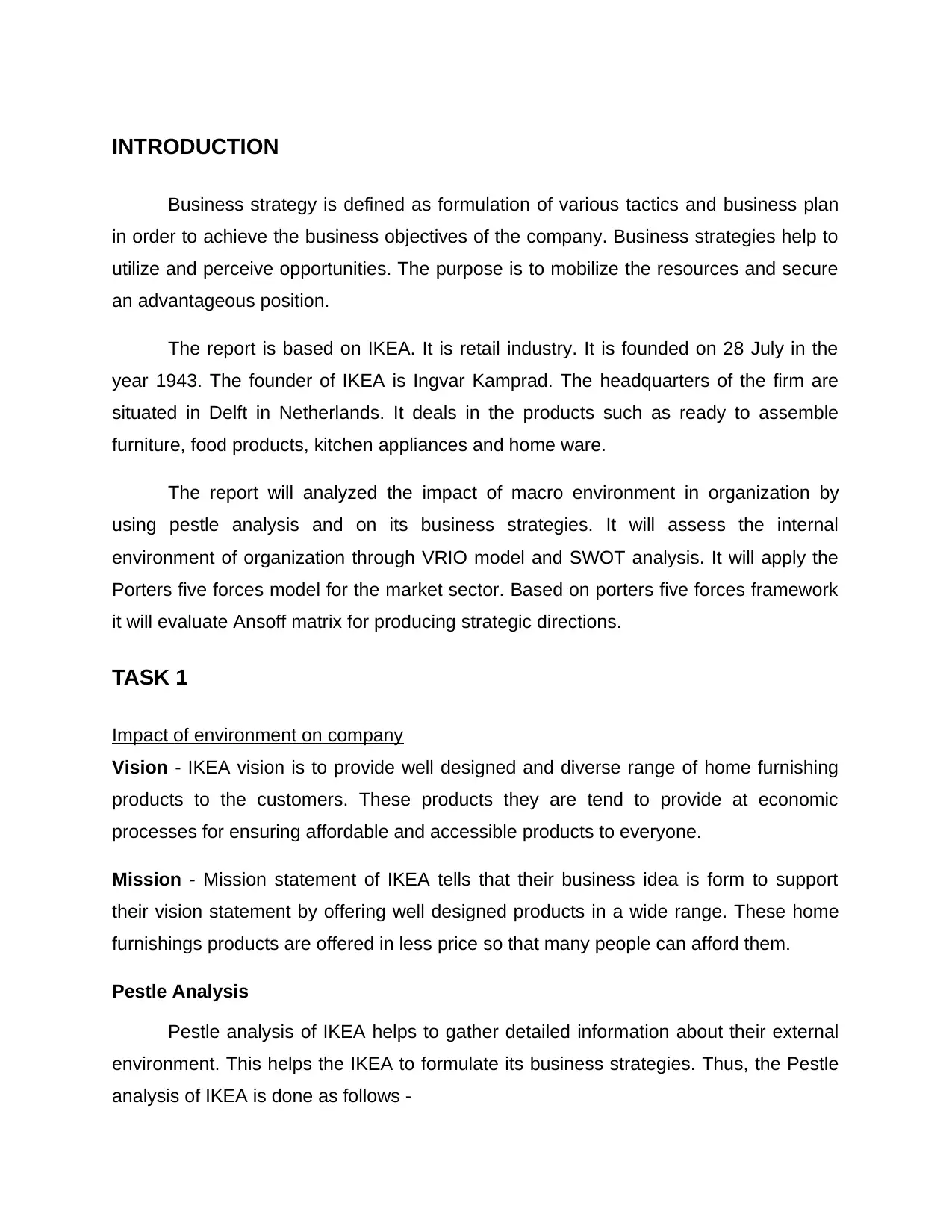
INTRODUCTION
Business strategy is defined as formulation of various tactics and business plan
in order to achieve the business objectives of the company. Business strategies help to
utilize and perceive opportunities. The purpose is to mobilize the resources and secure
an advantageous position.
The report is based on IKEA. It is retail industry. It is founded on 28 July in the
year 1943. The founder of IKEA is Ingvar Kamprad. The headquarters of the firm are
situated in Delft in Netherlands. It deals in the products such as ready to assemble
furniture, food products, kitchen appliances and home ware.
The report will analyzed the impact of macro environment in organization by
using pestle analysis and on its business strategies. It will assess the internal
environment of organization through VRIO model and SWOT analysis. It will apply the
Porters five forces model for the market sector. Based on porters five forces framework
it will evaluate Ansoff matrix for producing strategic directions.
TASK 1
Impact of environment on company
Vision - IKEA vision is to provide well designed and diverse range of home furnishing
products to the customers. These products they are tend to provide at economic
processes for ensuring affordable and accessible products to everyone.
Mission - Mission statement of IKEA tells that their business idea is form to support
their vision statement by offering well designed products in a wide range. These home
furnishings products are offered in less price so that many people can afford them.
Pestle Analysis
Pestle analysis of IKEA helps to gather detailed information about their external
environment. This helps the IKEA to formulate its business strategies. Thus, the Pestle
analysis of IKEA is done as follows -
Business strategy is defined as formulation of various tactics and business plan
in order to achieve the business objectives of the company. Business strategies help to
utilize and perceive opportunities. The purpose is to mobilize the resources and secure
an advantageous position.
The report is based on IKEA. It is retail industry. It is founded on 28 July in the
year 1943. The founder of IKEA is Ingvar Kamprad. The headquarters of the firm are
situated in Delft in Netherlands. It deals in the products such as ready to assemble
furniture, food products, kitchen appliances and home ware.
The report will analyzed the impact of macro environment in organization by
using pestle analysis and on its business strategies. It will assess the internal
environment of organization through VRIO model and SWOT analysis. It will apply the
Porters five forces model for the market sector. Based on porters five forces framework
it will evaluate Ansoff matrix for producing strategic directions.
TASK 1
Impact of environment on company
Vision - IKEA vision is to provide well designed and diverse range of home furnishing
products to the customers. These products they are tend to provide at economic
processes for ensuring affordable and accessible products to everyone.
Mission - Mission statement of IKEA tells that their business idea is form to support
their vision statement by offering well designed products in a wide range. These home
furnishings products are offered in less price so that many people can afford them.
Pestle Analysis
Pestle analysis of IKEA helps to gather detailed information about their external
environment. This helps the IKEA to formulate its business strategies. Thus, the Pestle
analysis of IKEA is done as follows -
⊘ This is a preview!⊘
Do you want full access?
Subscribe today to unlock all pages.

Trusted by 1+ million students worldwide
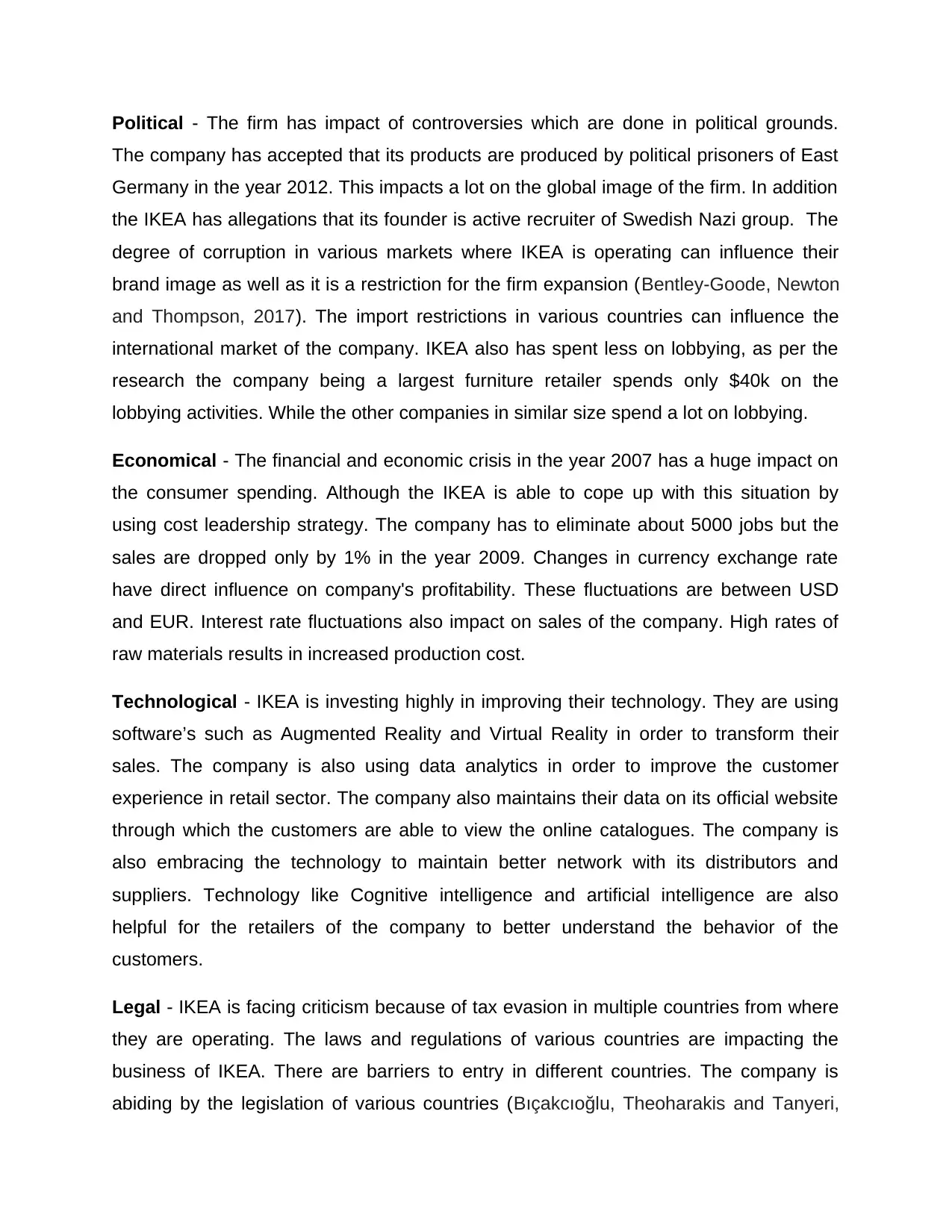
Political - The firm has impact of controversies which are done in political grounds.
The company has accepted that its products are produced by political prisoners of East
Germany in the year 2012. This impacts a lot on the global image of the firm. In addition
the IKEA has allegations that its founder is active recruiter of Swedish Nazi group. The
degree of corruption in various markets where IKEA is operating can influence their
brand image as well as it is a restriction for the firm expansion (Bentley-Goode, Newton
and Thompson, 2017). The import restrictions in various countries can influence the
international market of the company. IKEA also has spent less on lobbying, as per the
research the company being a largest furniture retailer spends only $40k on the
lobbying activities. While the other companies in similar size spend a lot on lobbying.
Economical - The financial and economic crisis in the year 2007 has a huge impact on
the consumer spending. Although the IKEA is able to cope up with this situation by
using cost leadership strategy. The company has to eliminate about 5000 jobs but the
sales are dropped only by 1% in the year 2009. Changes in currency exchange rate
have direct influence on company's profitability. These fluctuations are between USD
and EUR. Interest rate fluctuations also impact on sales of the company. High rates of
raw materials results in increased production cost.
Technological - IKEA is investing highly in improving their technology. They are using
software’s such as Augmented Reality and Virtual Reality in order to transform their
sales. The company is also using data analytics in order to improve the customer
experience in retail sector. The company also maintains their data on its official website
through which the customers are able to view the online catalogues. The company is
also embracing the technology to maintain better network with its distributors and
suppliers. Technology like Cognitive intelligence and artificial intelligence are also
helpful for the retailers of the company to better understand the behavior of the
customers.
Legal - IKEA is facing criticism because of tax evasion in multiple countries from where
they are operating. The laws and regulations of various countries are impacting the
business of IKEA. There are barriers to entry in different countries. The company is
abiding by the legislation of various countries (Bıçakcıoğlu, Theoharakis and Tanyeri,
The company has accepted that its products are produced by political prisoners of East
Germany in the year 2012. This impacts a lot on the global image of the firm. In addition
the IKEA has allegations that its founder is active recruiter of Swedish Nazi group. The
degree of corruption in various markets where IKEA is operating can influence their
brand image as well as it is a restriction for the firm expansion (Bentley-Goode, Newton
and Thompson, 2017). The import restrictions in various countries can influence the
international market of the company. IKEA also has spent less on lobbying, as per the
research the company being a largest furniture retailer spends only $40k on the
lobbying activities. While the other companies in similar size spend a lot on lobbying.
Economical - The financial and economic crisis in the year 2007 has a huge impact on
the consumer spending. Although the IKEA is able to cope up with this situation by
using cost leadership strategy. The company has to eliminate about 5000 jobs but the
sales are dropped only by 1% in the year 2009. Changes in currency exchange rate
have direct influence on company's profitability. These fluctuations are between USD
and EUR. Interest rate fluctuations also impact on sales of the company. High rates of
raw materials results in increased production cost.
Technological - IKEA is investing highly in improving their technology. They are using
software’s such as Augmented Reality and Virtual Reality in order to transform their
sales. The company is also using data analytics in order to improve the customer
experience in retail sector. The company also maintains their data on its official website
through which the customers are able to view the online catalogues. The company is
also embracing the technology to maintain better network with its distributors and
suppliers. Technology like Cognitive intelligence and artificial intelligence are also
helpful for the retailers of the company to better understand the behavior of the
customers.
Legal - IKEA is facing criticism because of tax evasion in multiple countries from where
they are operating. The laws and regulations of various countries are impacting the
business of IKEA. There are barriers to entry in different countries. The company is
abiding by the legislation of various countries (Bıçakcıoğlu, Theoharakis and Tanyeri,
Paraphrase This Document
Need a fresh take? Get an instant paraphrase of this document with our AI Paraphraser
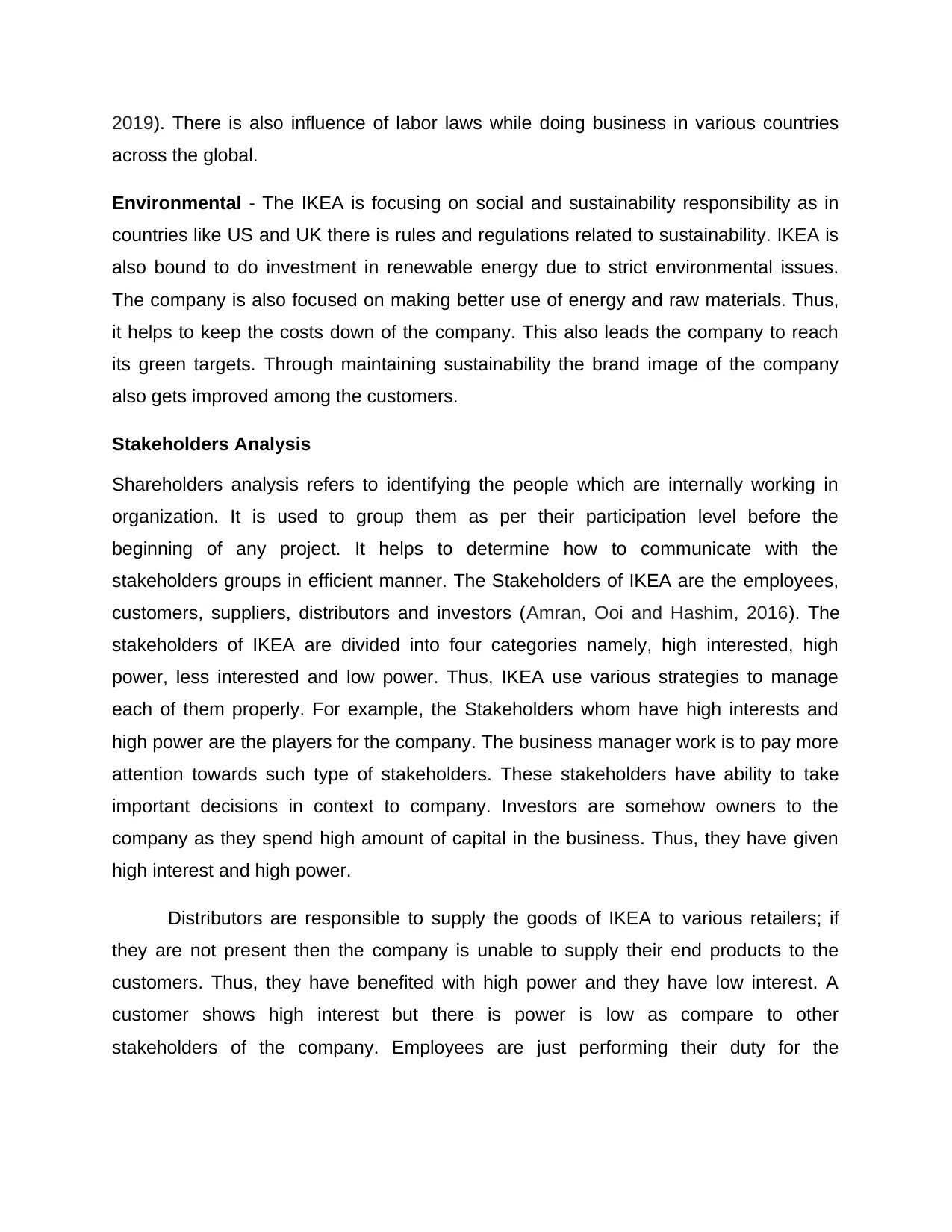
2019). There is also influence of labor laws while doing business in various countries
across the global.
Environmental - The IKEA is focusing on social and sustainability responsibility as in
countries like US and UK there is rules and regulations related to sustainability. IKEA is
also bound to do investment in renewable energy due to strict environmental issues.
The company is also focused on making better use of energy and raw materials. Thus,
it helps to keep the costs down of the company. This also leads the company to reach
its green targets. Through maintaining sustainability the brand image of the company
also gets improved among the customers.
Stakeholders Analysis
Shareholders analysis refers to identifying the people which are internally working in
organization. It is used to group them as per their participation level before the
beginning of any project. It helps to determine how to communicate with the
stakeholders groups in efficient manner. The Stakeholders of IKEA are the employees,
customers, suppliers, distributors and investors (Amran, Ooi and Hashim, 2016). The
stakeholders of IKEA are divided into four categories namely, high interested, high
power, less interested and low power. Thus, IKEA use various strategies to manage
each of them properly. For example, the Stakeholders whom have high interests and
high power are the players for the company. The business manager work is to pay more
attention towards such type of stakeholders. These stakeholders have ability to take
important decisions in context to company. Investors are somehow owners to the
company as they spend high amount of capital in the business. Thus, they have given
high interest and high power.
Distributors are responsible to supply the goods of IKEA to various retailers; if
they are not present then the company is unable to supply their end products to the
customers. Thus, they have benefited with high power and they have low interest. A
customer shows high interest but there is power is low as compare to other
stakeholders of the company. Employees are just performing their duty for the
across the global.
Environmental - The IKEA is focusing on social and sustainability responsibility as in
countries like US and UK there is rules and regulations related to sustainability. IKEA is
also bound to do investment in renewable energy due to strict environmental issues.
The company is also focused on making better use of energy and raw materials. Thus,
it helps to keep the costs down of the company. This also leads the company to reach
its green targets. Through maintaining sustainability the brand image of the company
also gets improved among the customers.
Stakeholders Analysis
Shareholders analysis refers to identifying the people which are internally working in
organization. It is used to group them as per their participation level before the
beginning of any project. It helps to determine how to communicate with the
stakeholders groups in efficient manner. The Stakeholders of IKEA are the employees,
customers, suppliers, distributors and investors (Amran, Ooi and Hashim, 2016). The
stakeholders of IKEA are divided into four categories namely, high interested, high
power, less interested and low power. Thus, IKEA use various strategies to manage
each of them properly. For example, the Stakeholders whom have high interests and
high power are the players for the company. The business manager work is to pay more
attention towards such type of stakeholders. These stakeholders have ability to take
important decisions in context to company. Investors are somehow owners to the
company as they spend high amount of capital in the business. Thus, they have given
high interest and high power.
Distributors are responsible to supply the goods of IKEA to various retailers; if
they are not present then the company is unable to supply their end products to the
customers. Thus, they have benefited with high power and they have low interest. A
customer shows high interest but there is power is low as compare to other
stakeholders of the company. Employees are just performing their duty for the
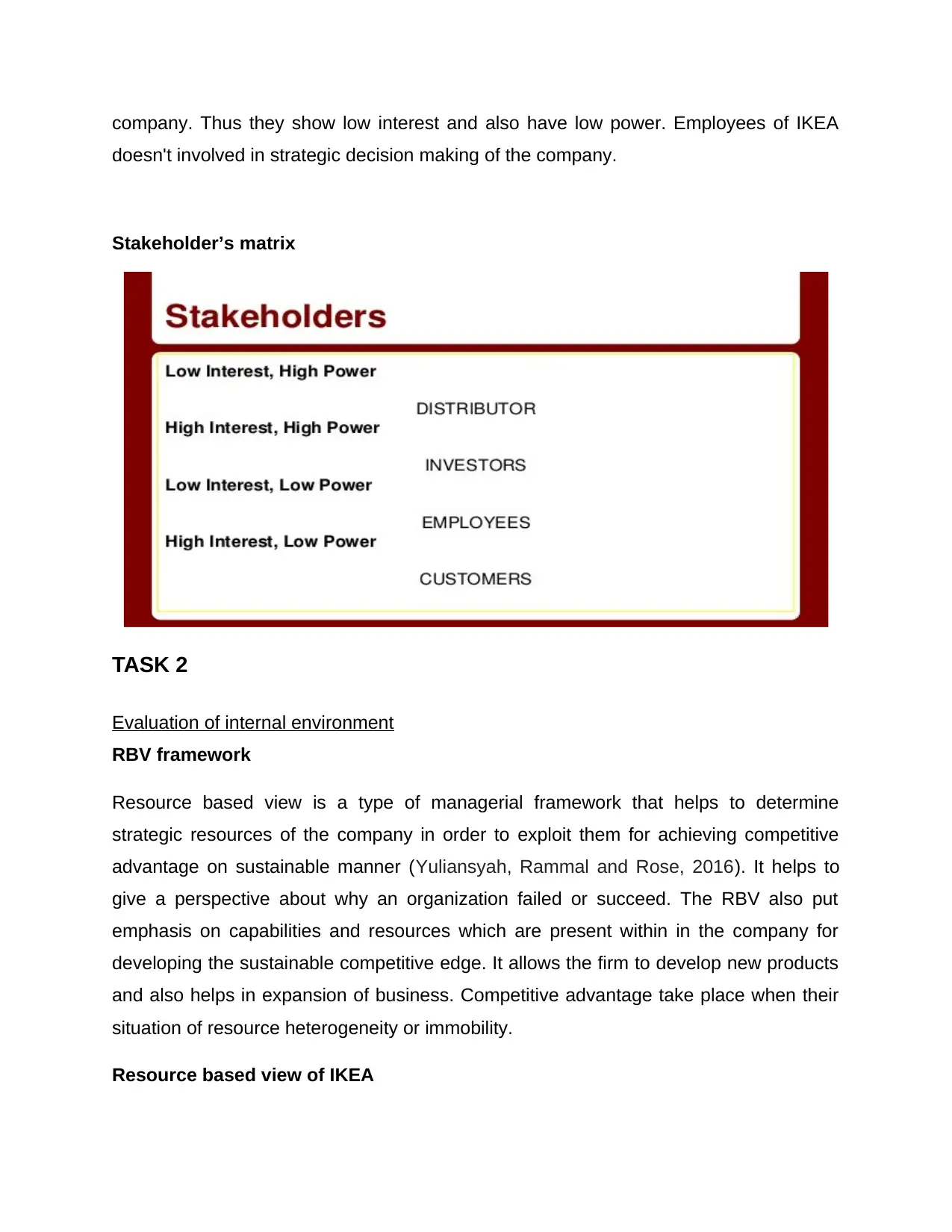
company. Thus they show low interest and also have low power. Employees of IKEA
doesn't involved in strategic decision making of the company.
Stakeholder’s matrix
TASK 2
Evaluation of internal environment
RBV framework
Resource based view is a type of managerial framework that helps to determine
strategic resources of the company in order to exploit them for achieving competitive
advantage on sustainable manner (Yuliansyah, Rammal and Rose, 2016). It helps to
give a perspective about why an organization failed or succeed. The RBV also put
emphasis on capabilities and resources which are present within in the company for
developing the sustainable competitive edge. It allows the firm to develop new products
and also helps in expansion of business. Competitive advantage take place when their
situation of resource heterogeneity or immobility.
Resource based view of IKEA
doesn't involved in strategic decision making of the company.
Stakeholder’s matrix
TASK 2
Evaluation of internal environment
RBV framework
Resource based view is a type of managerial framework that helps to determine
strategic resources of the company in order to exploit them for achieving competitive
advantage on sustainable manner (Yuliansyah, Rammal and Rose, 2016). It helps to
give a perspective about why an organization failed or succeed. The RBV also put
emphasis on capabilities and resources which are present within in the company for
developing the sustainable competitive edge. It allows the firm to develop new products
and also helps in expansion of business. Competitive advantage take place when their
situation of resource heterogeneity or immobility.
Resource based view of IKEA
⊘ This is a preview!⊘
Do you want full access?
Subscribe today to unlock all pages.

Trusted by 1+ million students worldwide
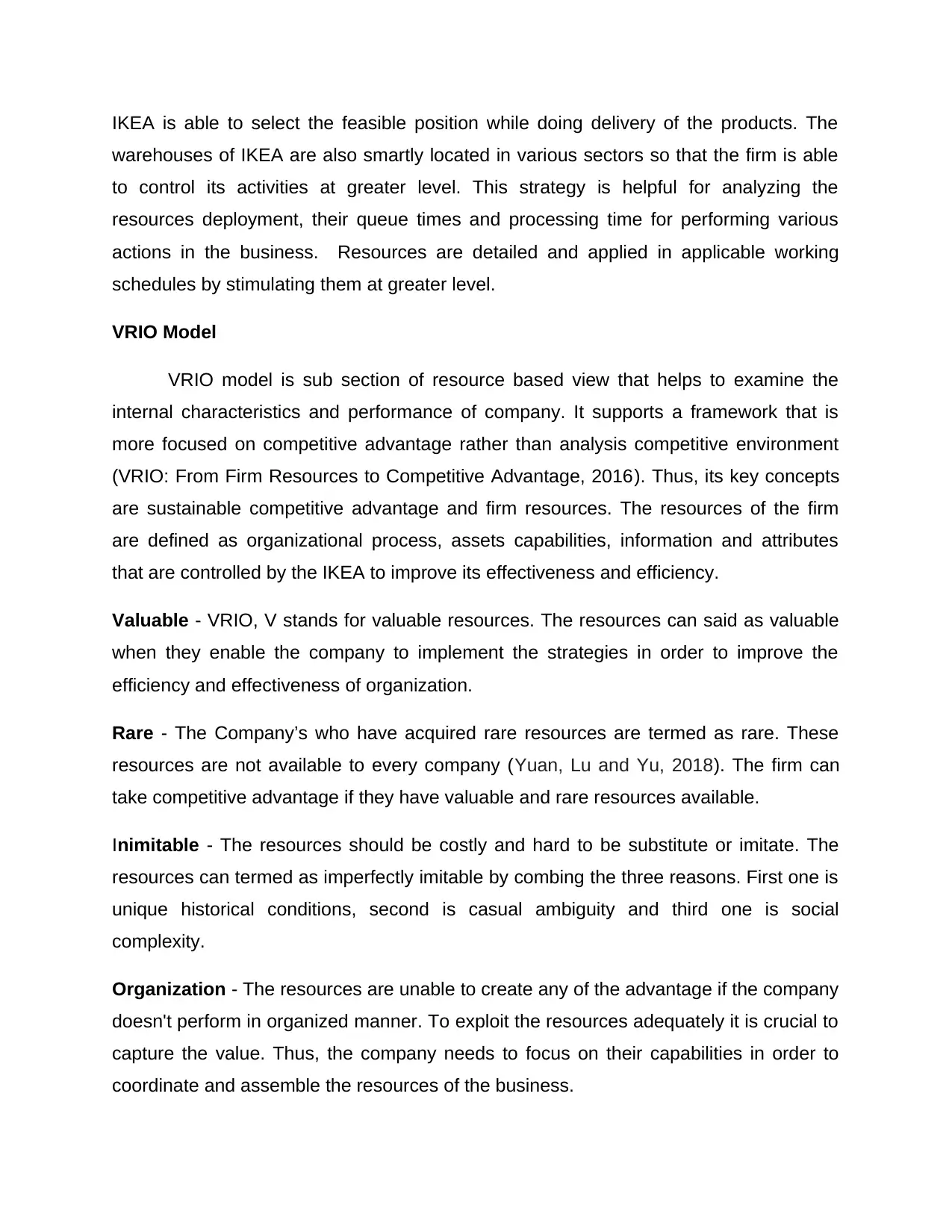
IKEA is able to select the feasible position while doing delivery of the products. The
warehouses of IKEA are also smartly located in various sectors so that the firm is able
to control its activities at greater level. This strategy is helpful for analyzing the
resources deployment, their queue times and processing time for performing various
actions in the business. Resources are detailed and applied in applicable working
schedules by stimulating them at greater level.
VRIO Model
VRIO model is sub section of resource based view that helps to examine the
internal characteristics and performance of company. It supports a framework that is
more focused on competitive advantage rather than analysis competitive environment
(VRIO: From Firm Resources to Competitive Advantage, 2016). Thus, its key concepts
are sustainable competitive advantage and firm resources. The resources of the firm
are defined as organizational process, assets capabilities, information and attributes
that are controlled by the IKEA to improve its effectiveness and efficiency.
Valuable - VRIO, V stands for valuable resources. The resources can said as valuable
when they enable the company to implement the strategies in order to improve the
efficiency and effectiveness of organization.
Rare - The Company’s who have acquired rare resources are termed as rare. These
resources are not available to every company (Yuan, Lu and Yu, 2018). The firm can
take competitive advantage if they have valuable and rare resources available.
Inimitable - The resources should be costly and hard to be substitute or imitate. The
resources can termed as imperfectly imitable by combing the three reasons. First one is
unique historical conditions, second is casual ambiguity and third one is social
complexity.
Organization - The resources are unable to create any of the advantage if the company
doesn't perform in organized manner. To exploit the resources adequately it is crucial to
capture the value. Thus, the company needs to focus on their capabilities in order to
coordinate and assemble the resources of the business.
warehouses of IKEA are also smartly located in various sectors so that the firm is able
to control its activities at greater level. This strategy is helpful for analyzing the
resources deployment, their queue times and processing time for performing various
actions in the business. Resources are detailed and applied in applicable working
schedules by stimulating them at greater level.
VRIO Model
VRIO model is sub section of resource based view that helps to examine the
internal characteristics and performance of company. It supports a framework that is
more focused on competitive advantage rather than analysis competitive environment
(VRIO: From Firm Resources to Competitive Advantage, 2016). Thus, its key concepts
are sustainable competitive advantage and firm resources. The resources of the firm
are defined as organizational process, assets capabilities, information and attributes
that are controlled by the IKEA to improve its effectiveness and efficiency.
Valuable - VRIO, V stands for valuable resources. The resources can said as valuable
when they enable the company to implement the strategies in order to improve the
efficiency and effectiveness of organization.
Rare - The Company’s who have acquired rare resources are termed as rare. These
resources are not available to every company (Yuan, Lu and Yu, 2018). The firm can
take competitive advantage if they have valuable and rare resources available.
Inimitable - The resources should be costly and hard to be substitute or imitate. The
resources can termed as imperfectly imitable by combing the three reasons. First one is
unique historical conditions, second is casual ambiguity and third one is social
complexity.
Organization - The resources are unable to create any of the advantage if the company
doesn't perform in organized manner. To exploit the resources adequately it is crucial to
capture the value. Thus, the company needs to focus on their capabilities in order to
coordinate and assemble the resources of the business.
Paraphrase This Document
Need a fresh take? Get an instant paraphrase of this document with our AI Paraphraser
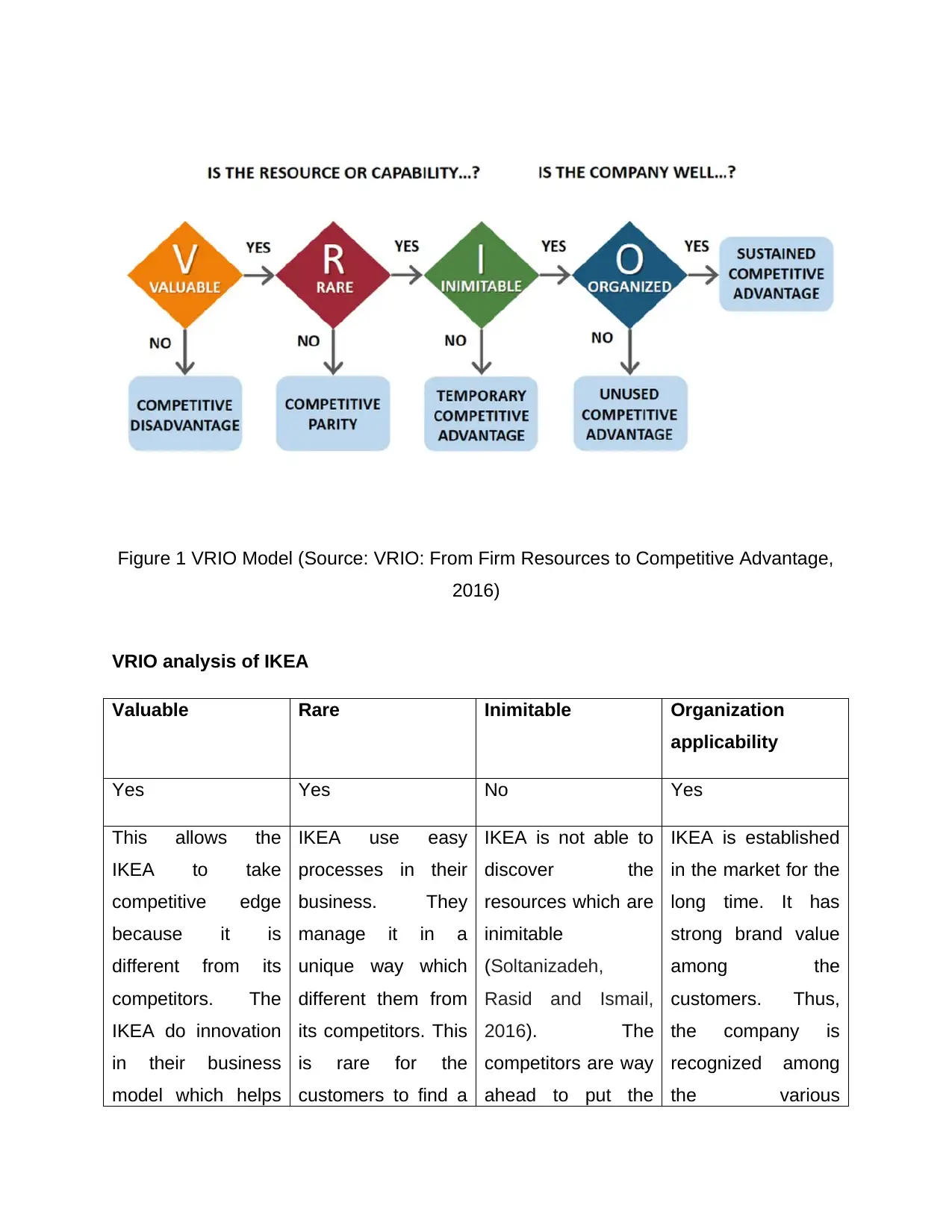
Figure 1 VRIO Model (Source: VRIO: From Firm Resources to Competitive Advantage,
2016)
VRIO analysis of IKEA
Valuable Rare Inimitable Organization
applicability
Yes Yes No Yes
This allows the
IKEA to take
competitive edge
because it is
different from its
competitors. The
IKEA do innovation
in their business
model which helps
IKEA use easy
processes in their
business. They
manage it in a
unique way which
different them from
its competitors. This
is rare for the
customers to find a
IKEA is not able to
discover the
resources which are
inimitable
(Soltanizadeh,
Rasid and Ismail,
2016). The
competitors are way
ahead to put the
IKEA is established
in the market for the
long time. It has
strong brand value
among the
customers. Thus,
the company is
recognized among
the various
2016)
VRIO analysis of IKEA
Valuable Rare Inimitable Organization
applicability
Yes Yes No Yes
This allows the
IKEA to take
competitive edge
because it is
different from its
competitors. The
IKEA do innovation
in their business
model which helps
IKEA use easy
processes in their
business. They
manage it in a
unique way which
different them from
its competitors. This
is rare for the
customers to find a
IKEA is not able to
discover the
resources which are
inimitable
(Soltanizadeh,
Rasid and Ismail,
2016). The
competitors are way
ahead to put the
IKEA is established
in the market for the
long time. It has
strong brand value
among the
customers. Thus,
the company is
recognized among
the various
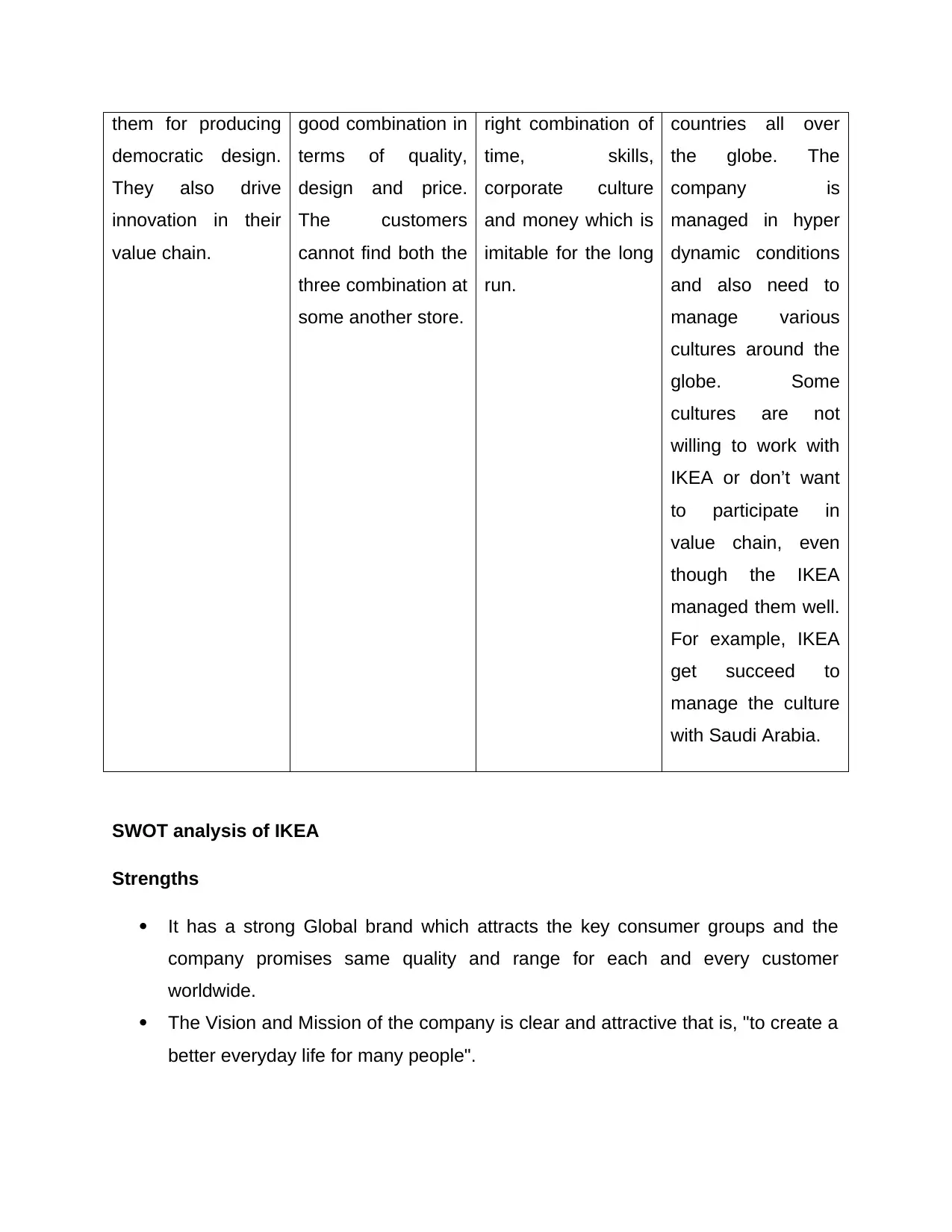
them for producing
democratic design.
They also drive
innovation in their
value chain.
good combination in
terms of quality,
design and price.
The customers
cannot find both the
three combination at
some another store.
right combination of
time, skills,
corporate culture
and money which is
imitable for the long
run.
countries all over
the globe. The
company is
managed in hyper
dynamic conditions
and also need to
manage various
cultures around the
globe. Some
cultures are not
willing to work with
IKEA or don’t want
to participate in
value chain, even
though the IKEA
managed them well.
For example, IKEA
get succeed to
manage the culture
with Saudi Arabia.
SWOT analysis of IKEA
Strengths
It has a strong Global brand which attracts the key consumer groups and the
company promises same quality and range for each and every customer
worldwide.
The Vision and Mission of the company is clear and attractive that is, "to create a
better everyday life for many people".
democratic design.
They also drive
innovation in their
value chain.
good combination in
terms of quality,
design and price.
The customers
cannot find both the
three combination at
some another store.
right combination of
time, skills,
corporate culture
and money which is
imitable for the long
run.
countries all over
the globe. The
company is
managed in hyper
dynamic conditions
and also need to
manage various
cultures around the
globe. Some
cultures are not
willing to work with
IKEA or don’t want
to participate in
value chain, even
though the IKEA
managed them well.
For example, IKEA
get succeed to
manage the culture
with Saudi Arabia.
SWOT analysis of IKEA
Strengths
It has a strong Global brand which attracts the key consumer groups and the
company promises same quality and range for each and every customer
worldwide.
The Vision and Mission of the company is clear and attractive that is, "to create a
better everyday life for many people".
⊘ This is a preview!⊘
Do you want full access?
Subscribe today to unlock all pages.

Trusted by 1+ million students worldwide
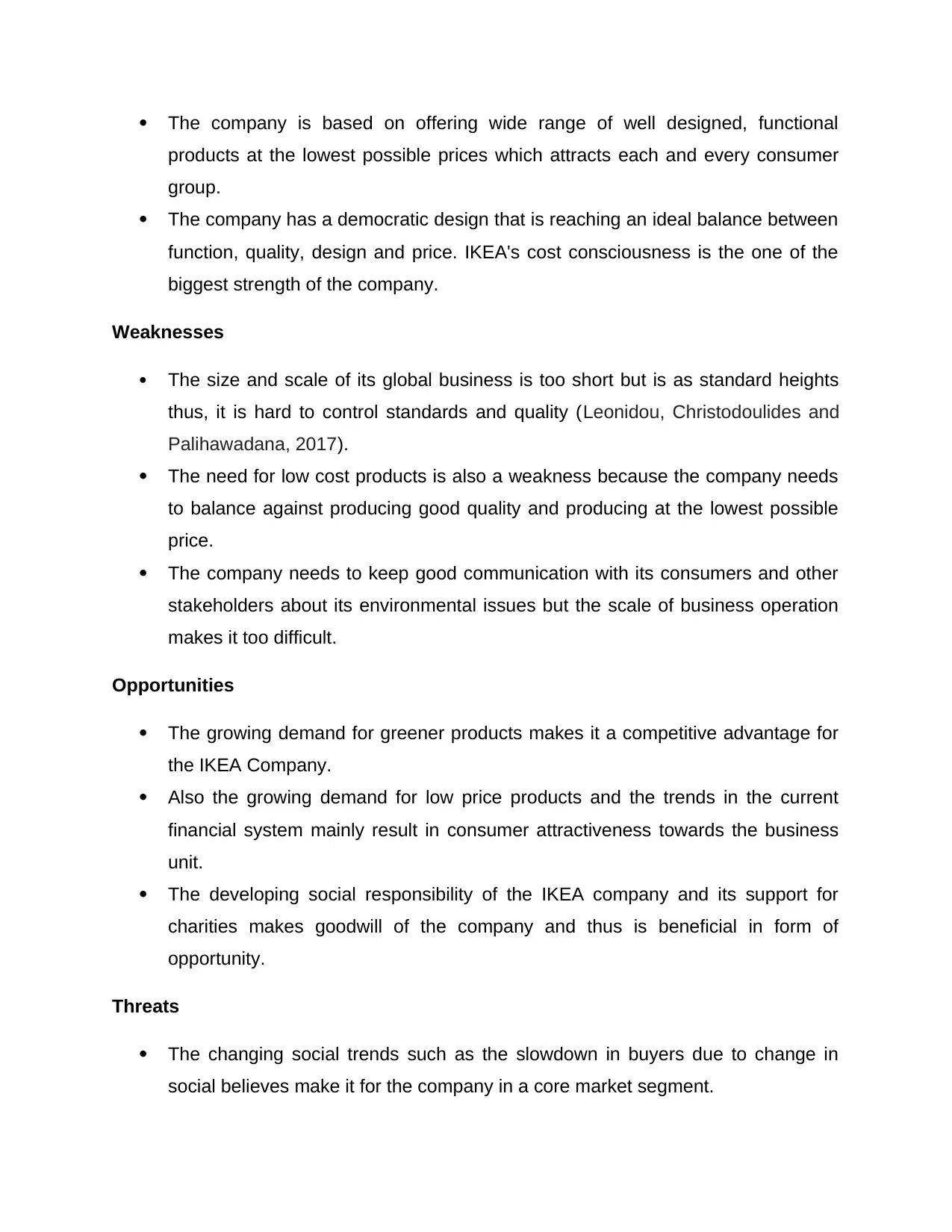
The company is based on offering wide range of well designed, functional
products at the lowest possible prices which attracts each and every consumer
group.
The company has a democratic design that is reaching an ideal balance between
function, quality, design and price. IKEA's cost consciousness is the one of the
biggest strength of the company.
Weaknesses
The size and scale of its global business is too short but is as standard heights
thus, it is hard to control standards and quality (Leonidou, Christodoulides and
Palihawadana, 2017).
The need for low cost products is also a weakness because the company needs
to balance against producing good quality and producing at the lowest possible
price.
The company needs to keep good communication with its consumers and other
stakeholders about its environmental issues but the scale of business operation
makes it too difficult.
Opportunities
The growing demand for greener products makes it a competitive advantage for
the IKEA Company.
Also the growing demand for low price products and the trends in the current
financial system mainly result in consumer attractiveness towards the business
unit.
The developing social responsibility of the IKEA company and its support for
charities makes goodwill of the company and thus is beneficial in form of
opportunity.
Threats
The changing social trends such as the slowdown in buyers due to change in
social believes make it for the company in a core market segment.
products at the lowest possible prices which attracts each and every consumer
group.
The company has a democratic design that is reaching an ideal balance between
function, quality, design and price. IKEA's cost consciousness is the one of the
biggest strength of the company.
Weaknesses
The size and scale of its global business is too short but is as standard heights
thus, it is hard to control standards and quality (Leonidou, Christodoulides and
Palihawadana, 2017).
The need for low cost products is also a weakness because the company needs
to balance against producing good quality and producing at the lowest possible
price.
The company needs to keep good communication with its consumers and other
stakeholders about its environmental issues but the scale of business operation
makes it too difficult.
Opportunities
The growing demand for greener products makes it a competitive advantage for
the IKEA Company.
Also the growing demand for low price products and the trends in the current
financial system mainly result in consumer attractiveness towards the business
unit.
The developing social responsibility of the IKEA company and its support for
charities makes goodwill of the company and thus is beneficial in form of
opportunity.
Threats
The changing social trends such as the slowdown in buyers due to change in
social believes make it for the company in a core market segment.
Paraphrase This Document
Need a fresh take? Get an instant paraphrase of this document with our AI Paraphraser
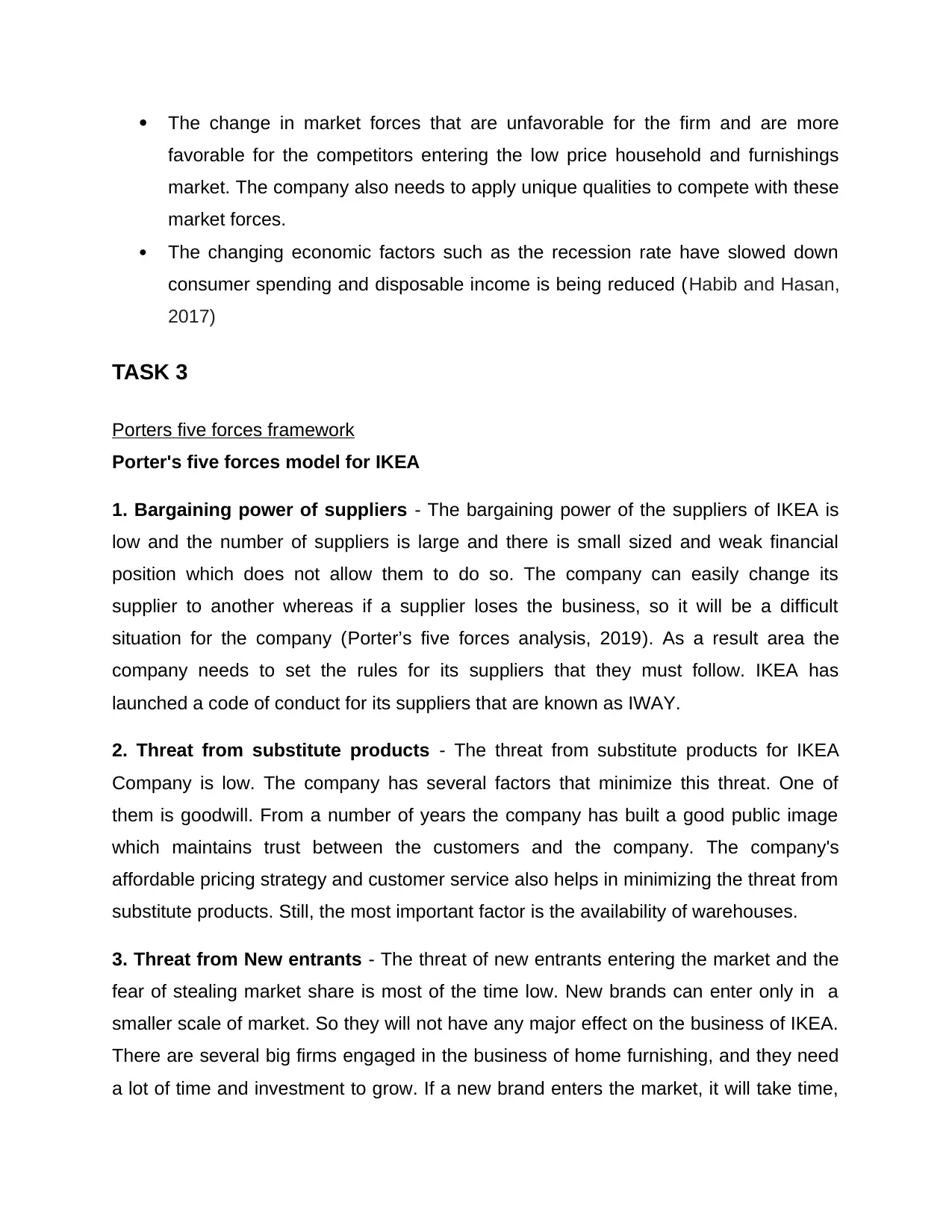
The change in market forces that are unfavorable for the firm and are more
favorable for the competitors entering the low price household and furnishings
market. The company also needs to apply unique qualities to compete with these
market forces.
The changing economic factors such as the recession rate have slowed down
consumer spending and disposable income is being reduced (Habib and Hasan,
2017)
TASK 3
Porters five forces framework
Porter's five forces model for IKEA
1. Bargaining power of suppliers - The bargaining power of the suppliers of IKEA is
low and the number of suppliers is large and there is small sized and weak financial
position which does not allow them to do so. The company can easily change its
supplier to another whereas if a supplier loses the business, so it will be a difficult
situation for the company (Porter’s five forces analysis, 2019). As a result area the
company needs to set the rules for its suppliers that they must follow. IKEA has
launched a code of conduct for its suppliers that are known as IWAY.
2. Threat from substitute products - The threat from substitute products for IKEA
Company is low. The company has several factors that minimize this threat. One of
them is goodwill. From a number of years the company has built a good public image
which maintains trust between the customers and the company. The company's
affordable pricing strategy and customer service also helps in minimizing the threat from
substitute products. Still, the most important factor is the availability of warehouses.
3. Threat from New entrants - The threat of new entrants entering the market and the
fear of stealing market share is most of the time low. New brands can enter only in a
smaller scale of market. So they will not have any major effect on the business of IKEA.
There are several big firms engaged in the business of home furnishing, and they need
a lot of time and investment to grow. If a new brand enters the market, it will take time,
favorable for the competitors entering the low price household and furnishings
market. The company also needs to apply unique qualities to compete with these
market forces.
The changing economic factors such as the recession rate have slowed down
consumer spending and disposable income is being reduced (Habib and Hasan,
2017)
TASK 3
Porters five forces framework
Porter's five forces model for IKEA
1. Bargaining power of suppliers - The bargaining power of the suppliers of IKEA is
low and the number of suppliers is large and there is small sized and weak financial
position which does not allow them to do so. The company can easily change its
supplier to another whereas if a supplier loses the business, so it will be a difficult
situation for the company (Porter’s five forces analysis, 2019). As a result area the
company needs to set the rules for its suppliers that they must follow. IKEA has
launched a code of conduct for its suppliers that are known as IWAY.
2. Threat from substitute products - The threat from substitute products for IKEA
Company is low. The company has several factors that minimize this threat. One of
them is goodwill. From a number of years the company has built a good public image
which maintains trust between the customers and the company. The company's
affordable pricing strategy and customer service also helps in minimizing the threat from
substitute products. Still, the most important factor is the availability of warehouses.
3. Threat from New entrants - The threat of new entrants entering the market and the
fear of stealing market share is most of the time low. New brands can enter only in a
smaller scale of market. So they will not have any major effect on the business of IKEA.
There are several big firms engaged in the business of home furnishing, and they need
a lot of time and investment to grow. If a new brand enters the market, it will take time,
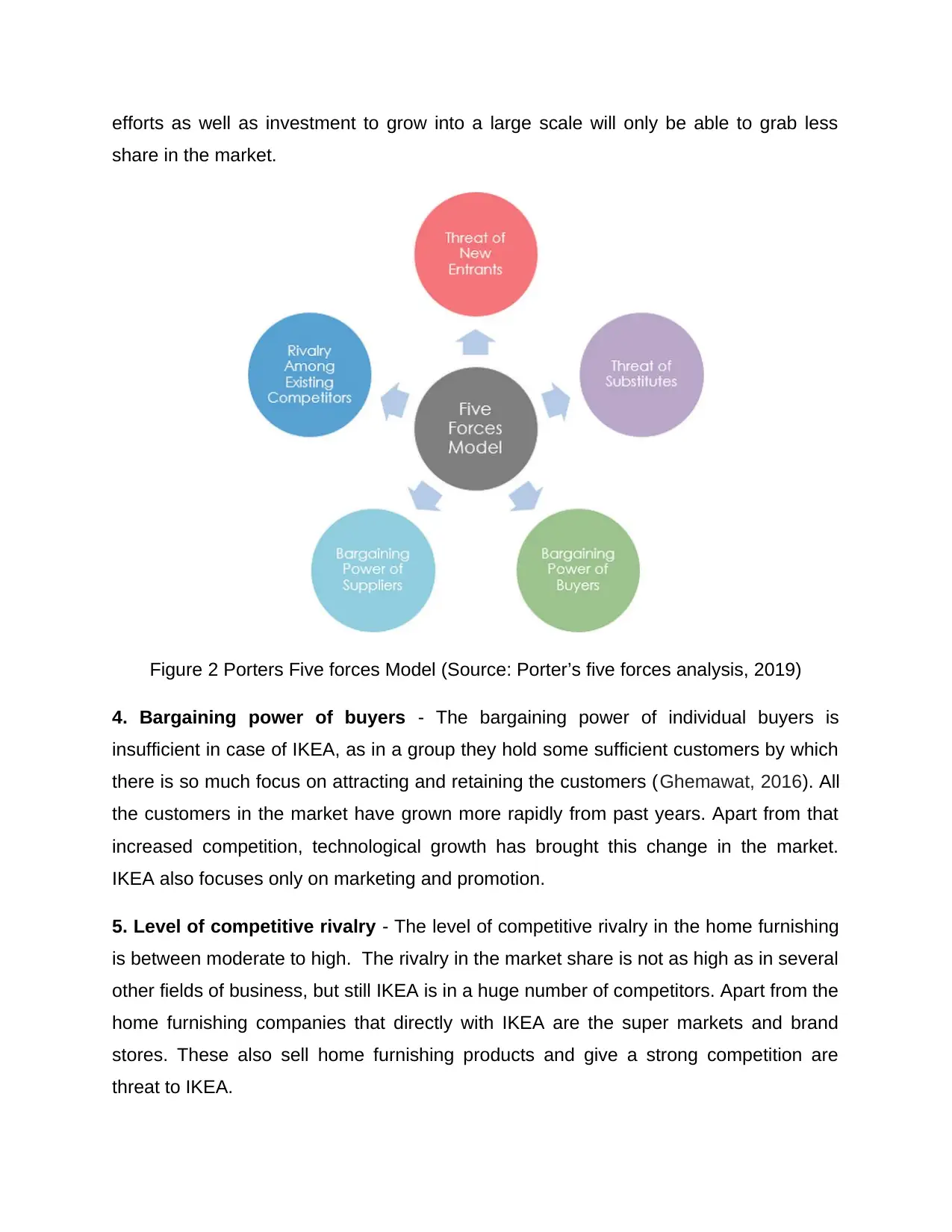
efforts as well as investment to grow into a large scale will only be able to grab less
share in the market.
Figure 2 Porters Five forces Model (Source: Porter’s five forces analysis, 2019)
4. Bargaining power of buyers - The bargaining power of individual buyers is
insufficient in case of IKEA, as in a group they hold some sufficient customers by which
there is so much focus on attracting and retaining the customers (Ghemawat, 2016). All
the customers in the market have grown more rapidly from past years. Apart from that
increased competition, technological growth has brought this change in the market.
IKEA also focuses only on marketing and promotion.
5. Level of competitive rivalry - The level of competitive rivalry in the home furnishing
is between moderate to high. The rivalry in the market share is not as high as in several
other fields of business, but still IKEA is in a huge number of competitors. Apart from the
home furnishing companies that directly with IKEA are the super markets and brand
stores. These also sell home furnishing products and give a strong competition are
threat to IKEA.
share in the market.
Figure 2 Porters Five forces Model (Source: Porter’s five forces analysis, 2019)
4. Bargaining power of buyers - The bargaining power of individual buyers is
insufficient in case of IKEA, as in a group they hold some sufficient customers by which
there is so much focus on attracting and retaining the customers (Ghemawat, 2016). All
the customers in the market have grown more rapidly from past years. Apart from that
increased competition, technological growth has brought this change in the market.
IKEA also focuses only on marketing and promotion.
5. Level of competitive rivalry - The level of competitive rivalry in the home furnishing
is between moderate to high. The rivalry in the market share is not as high as in several
other fields of business, but still IKEA is in a huge number of competitors. Apart from the
home furnishing companies that directly with IKEA are the super markets and brand
stores. These also sell home furnishing products and give a strong competition are
threat to IKEA.
⊘ This is a preview!⊘
Do you want full access?
Subscribe today to unlock all pages.

Trusted by 1+ million students worldwide
1 out of 18
Related Documents
Your All-in-One AI-Powered Toolkit for Academic Success.
+13062052269
info@desklib.com
Available 24*7 on WhatsApp / Email
![[object Object]](/_next/static/media/star-bottom.7253800d.svg)
Unlock your academic potential
Copyright © 2020–2025 A2Z Services. All Rights Reserved. Developed and managed by ZUCOL.





